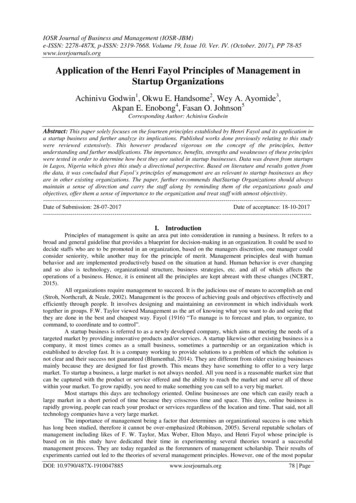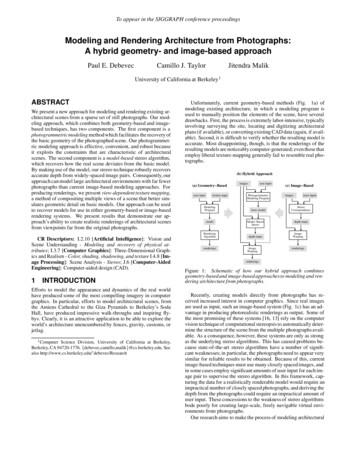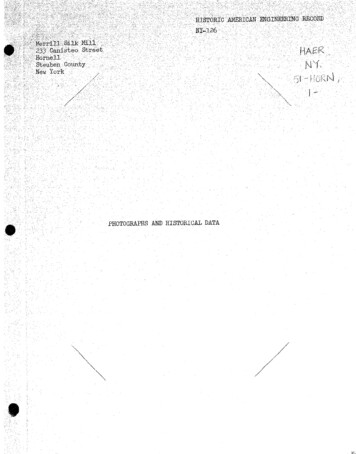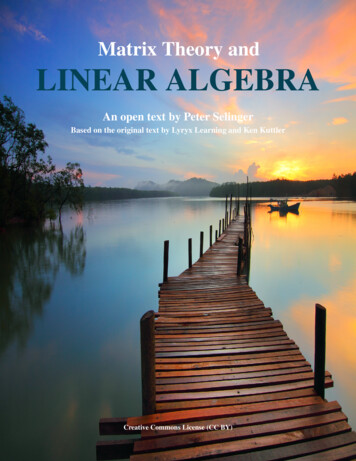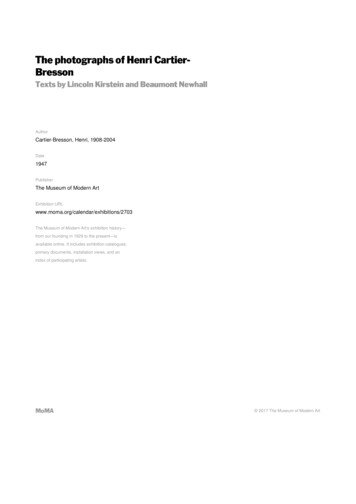
Transcription
The photographs of Henri CartierBressonTexts by Lincoln Kirstein and Beaumont NewhallAuthorCartier-Bresson, Henri, 1908-2004Date1947PublisherThe Museum of Modern ArtExhibition URLwww.moma.org/calendar/exhibitions/2703The Museum of Modern Art's exhibition history—from our founding in 1929 to the present—isavailable online. It includes exhibition catalogues,primary documents, installation views, and anindex of participating artists.MoMA 2017 The Museum of Modern Art
IHENRICARTIER- BRESSON
HNTHE MUSEUMOF MQDE ARTReccvi*
HENRICARTIER- BRESSON
THEPHOTOGRAPHSOFHENRICARTIER- BRESSONTEXTSBY LINCOLNKIRSTEINANDBEAUMONTNEWHALLTHE MUSEUM OF MODERN ART
ftACKNOWLEDGMENTSThe Museumof Modern Art extends grateful acknowledgment:to Pierre Braun, EditionsBraun & Cie., Paris, and to Erich S. Herrmannproduced on pages 6, 48, 49, 50, 51 and 53 to be publishedto E. Teriade,Verve, Paris, for the photographsrein the collection visages (Taujourd'hui.reproducedto Mrs. Caresse Crosby, Black Sun Press, Washington,for the photographson pages 22, 23, 28, 36 and 45.D. C., for the photographsreproducedon pages 39 and 41 from Portfolio, 1945.1to Mrs. Carmel Snow, Harper s Bazaar,New York, for the photographsreproducedon pagesAllen Moe, 1st Vice-Chairman;William42, 43, 46, 47, 52 and 55.TRUSTEESOF THE MUSEUM OF MODERN ARTJohn Hay Whitney,A. M. Burden,PhilipL. Goodwin,John E. Abbott,Mrs. Robertof the board; Henry2nd Vice-Chairman ; Sam A. Lewisohn,feller, President;President;ChairmanSecretary ; RanaldWoods Bliss, StephenField, A. Conger Goodyear,Payson,Warburg,Mrs. John D. Rockefeller,H. Macdonald,Treasurer,Rene d'Harnoncourt,Nelson A. RockeM. Levy,Jr., Beardsley2nd Vice-Alfred H. Barr,Walt Disney,Wallace K. Harrison,Jr.,MarshallJames W. Husted,William S. Paley, Mrs. E. B. Parkinson,Mrs. George Henry Warren,HONORARYFredericC. Clark,Mrs. Simon Guggenheim,Henry R. Luce, David H. McAlpin,3rd Vice-Chairman;1st Vice-President ; Mrs. DavidMrs. Charles S.Ruml, James Thrall Soby, EdwardM. M.Monroe Wheeler.TRUSTEESClay Bartlett,Mrs. W. MurrayCrane, FrankCrowninshield,DuncanPhillips, PaulJ. Sachs, Mrs. John S. Sheppard.Copyright 1947, The Museum of Modern Art, 11 If est 53 Street, New York 19, N. Y. Printed in the U.S.A.Eleven thousand seven hundred copies of this book were printed in January,1947, for the Trustees of The Museumof Modern Art by The Plantin Press, New York.4
CONTENTSPAGEACKNOWLEDGMENTS4HENRI CARTIER-BRESSON: DOCUMENTARY HUMANISTBY LINCOLN KIRSTEIN7CARTIER-BRESSON'S PHOTOGRAPHIC TECHNIQUEBY BEAUMONT NEWHALL12CHRONOLOGY15PLATES16BIBLIOGRAPHY56 *
Henri-Matissein Vence (Alpes Maritimes),1944
HENRI CARTIER-BRESSON:DOCUMENTARY HUMANISTA numberof contemporaryto hotographersPerhapsare unitedwho, by his denial of the academichas takentowardsthe leading Europeansequencesof picturesformulatingexponent"artistic"a new approachof this directionis Henrior salon taste of modernwhich in their freshness,eleganceart-and truthremain works of art within their own radical esthetic.Since the discoveryof photography,fusion as to its functionover a centuryago, there has been recurrentand effect. At first there was the giddy sense, amountingfright, that the camera-lenshad spoiled any future for representationalpainting,conalmost tomaking anyfurtherrealistic renderingby the hand and brush useless. At the same time and a little later,certainpaintersoccupiedwith basic problemsDegas,Eakins)employedeven the accidentsforced perspective — as new pictorialwith figures cut arbitrarilyAnd yet, historicallyaccident,houses.*in the arrangementof photographyby the frame,woodcuts,when it was realized that easel-painterssalon -photographersand that the prestigeattemptedto imitatethe mechanismfor its uniquethe vision of an instantaneoussliced to fit on the slim posts of teahad nothing to fear and even much toof the paintercould remainor rival painterlyuse of the camera, the line of salon -photographersacceptedservices,'quality.'occupied themselvesintact,compositions.a school ofFromand createdsomethingwith texture,''atmosphere'The pictures they posed, however, except possibly for strictly documentaryof people or places, did not long satisfy as independentthe photographer,the elements of composition,fused into an image with a continuousthe greatest painting.and the additionand simulacraas a popularPhotographsof hand-paintedof paint.atmosphereeven failed to be convincinganonymitymasses of journalisticshots, every so often a few wonderful* See "The Photographicpages 15-26.Eye," by A. Hyatt Mayor, Bulletin,andportraitshow sagaciousmade possible byframed and glazed decorationswere at once post cardsthe more ambitious,in the promiscuousButand quality could not bedid not help. PhotographsBad taste accompaniedcraft was expressedtexture,works of art. No matterlife of its own, equalling the synthesistintingthe firstwas paralleled by men whose candor of visionwith it. Such were the prints of Nadar and Brady, and many anonymousthe salon-photographersfocus,of the snapshot,was deftly used by Degas and Toulouse-Lautrec.borrowed from the strips of JapaneseAfterwards,— lack of a sharpeneddevices. Even the candid compositionspeaking, it was Manet who had introducedgain from the camera,of form and light (Corot,humanMetropolitanand soon photographyof journalism.But in theimages emerged,and, ifMuseum of Art, Summer 1946,7
this was usuallyappeal.accidental,the pictureswere none the less effectivefor their unconsciousAnd these images have never failed to excite and affect present-dayeasel-painters,who, like Yerineer and Manet before thein, can always be moved by the miraculousof light and the surprise of suddenlyThen certainartists,primarilyinterestedin the use of the camera,aware of the naive, or at least half-consciouslythe frank attitudeprogram.trainedformulatedof the reporter-photographer,school the non-selectiveprimitiveIt is also noteworthyas painters.thatjournalisticwho had been madeapproach,but now with deliberateeye, with all its piquantand were considerablydesign. They began tohumanistswere alsoWalker Evans (who has quite a differinfluencedby the folk-culturesand Polynesia.photographers,and others of their school, are as familiar with the creative impulse as painters.mediumBrassai is a talentedof Africa,the CaribbeanThey work with a differentThe photographerbegan to usemishaps, to their own sophisticatedseveral of our best documentaryCartier- Bresson and the Americanent style) have both painted,accidentsfixed frames.and a more mechanicalThe decisive part of Cartier- Bresson's particulardraughtsman.Theseprocess.process takes place not in the mechanismin his hand hut in the vision in his head; in that right eye which (he says) looks out onto theexterior world, and that left eye which looks inside to his personal world. The vision fuses onwhat he sees, where and when, and how he feels about it. His picturesphoto of a daily crime or a sporting event than to the naive perfectionare closer to the newsof the still-life groups ofthe great chronicler of Paris in the early 1900s, Eugene Atget. But while a news-photois brutal,factual and public or official, and the great human interest in Atget is more by implicationinanimateobjects, Cartier-Bresson,image, not strippedof light and air, but close to the figures involved, to their private identities,their social origin and habits and the local site. And, while news-photographerscatastrophe,the photo-finishseries. His early shot of childrena specimen -slice or symbolic fragment,aster. No image since has providedfield of investigationand of infinite differences of personal comment.to recapturelong time to suit his temperament;Atget, despite the apparentphotographer,of an imminentdecade of disanonymityBill Brandt,not painter),styles may be developedfor individualhis set of lyric values, r-BressonWalkerEvans,andHelenthewithin their program.otherLevitt,and Weegee, for example — show how manyover aThere was only oneof his plates, and his countless subsequentbetweenof humanThere is no reason for anyone else to ape hisit would be possible only as dilution.The very real differenceshumanists- —Brassai,was prophecyfeels that an insistence on the direct and indirect documentationeye or to attemptfrom asuch a powerful report of fused innocence and destruction,behavior by the camera offers an unlimitedimitators.are seized insnapped(page 17) playing in ruins of plaster walls whose holes seemtorn out of the paper on which they are printedparticularspecialize inor some aspect of shock, Cartier- Bresson's picturesthe middle norm of a run of action,of fun and fright.Cartier-Bressonfromwith means as modest, gives us an intense and questioningand carelessdocumentaryBen Shahnstrongly(aspersonal
Cartier-Bresson'sparticulareasy internationalism,personalityis Parisianand Norman.From Paris he gains hishis ability to pass in or out of any milieu however exotic, dangerousorboring, without wasting his time. He went off for a year in West Africa with no more equipmentthan a pair of his father's old pants, a new sun-helmetfor Mexico without troublingand a thousand-francto find out on whose responsibilitynote. He embarkedor authorityhis vague expedition was based and, of course, it blew up. But he got to know Africa and Mexico as no welloutfittedtouristever could. He never loses himself in mere nostalgictrasts of new people and far places do not overwhelmexotic is essential in its integritytravelogueromanceFrom Normandyor candor,as another equally interestingor soft-focuscomes his "frugal elegance and peasantof taking picturesdignitythe instrumentsspecializedbut quite withoutshrewdness,an independentand pride in his own brand of technique,chillwhich isthan of talking to people and getting along well with them sothey will not shrink from him, or "pose"medium;phenomenon,the conpart of thebrooding.and also a transparentless a matterstrangeness;him. He accepts whateverfor him. He has an antagonismare for use like a plane or a square,to gadgetryin hisand his craftsmanshipis lessthan specific for his needs. He does not have much of a feeling for the dark room.Here he supervisesthe technicianfor, after all, what he has seen is alreadyimplicitin whatappears in the negative and on the print. He has taken a sequence of trial shots, dancing abouthis subject on tip toe, like a boxer or fencer, until he chooses the ultimatethen traps it in time. He considerstalents (which are considerable)with pictorialsatisfied.journalism,his own assignmentsas an ordinaryworkmanby them. Peacetimeof his practicaldoes his labor. Should he be occupiedvery well then, there are the usual conditionsHe is not hamperedframe and instance;and the exploitationof his editorsis different from war, but not necessarilyeasier. The war in Spain is different from the war in France. The parlor of a wine-masterLoire certainlydiffers from those of Bonnard or Rouault,spends the time as an agreeableThere is a discreet Parisianhe transferslightnessand wherever he happens to work heas well as a Normanhow unlike the usual conscientiousthetic towards his sitters or assignmentsWithoutof theand almost invisible guest.to his prints. His cheeriness, his dispassionateself-effacement:to berigor in his personalitycuriosity,his stubbornor case-hardenedreporter.whichattentionandHe is sympain the way of a good nurse with a fractiouspatient.allowing them to be aware of it — which might somehow remind them of their condition, or their habitualtheir vanities,defenses — he puts them at ease, makes them quite comfortable,involves them deeply in their own currentstinues the conversationas if nothing had happened,never cutting the ordinaryflow of atmosphereof action, takes his pictures,with his follow-throughallaysconin the entire processby a self-conscious or unconsciousflirtationwiththe camera on the part of the sitter or subject.Sometimesand somehow,almost out of a superiorable to leave his lens out of the picture. His portraittakencroppedat tactfulintervals,down after printing.by eavesdroppingcraftsman'sgood manners,he seemssubjects are not shot; they get themselvesor absorption.His picturesHe does not have to try to save a compositionare not generallyby eliminatinga9
band or an edge, here or there. His finest shots are discoveredratherdoes not go in for the systematicof an interior,renderit more "picturesque"Frenchwritersdisruptionor rearrangementor "characteristic."and paintersis so valuable.Thatis why his recentBy avoidingthose recently developed in the mode of the "candid"any factitiousthe maximumarrangementto his subjectwith the preoccupiedintensityboxer landinga knockout,it was by Nadar.exhaustswith so much penetrationit is this very intensity,his energy and renders Cartier-Bressonnotchby notchdefeat the cliches of photograthe variousaccuracy.requireindifferentThe series on the painterFrenchdomesticlife, thatBonnardconstantand incidentssort of energy,life. The face of Paul Claudelsyntheticand baroquesplendor into the languagepuckeredold clown'sdomesticdecor, a combinationand pictorial,wisdom of RouaultSartreof colonial deputations,dignityrestaurantand shabbytribal complacencyof idiosyncrasy,of the raptmass.humanpenmanship,Communistat thoseGovernment."skin as oiled leather,Cartier-Bressonpersonality,with every pore ahas ratherWith a kind of bland abnegationof his own accidentalLookingmot: "Remember,of surface or tonal values as such, whichthe more he becomes the crystal eye, the more his picturespreferredtohe manages to avoidof his individualBut the more he effaces himself, the more he ignores his particularraneity,ofof the prothe ancient London streets, however appealingan interest in the renditionwhet his historical and moral perceptions.the intrusionof Matisse'sturns his back on the majestywhen the time comes, it will be His Majesty'sleads them to presentand(page 50).gentlemen,pit and every hair a stroke of engravedhomily(page 47), the(page 52), and the bold elaborationfaces we are all the more conscious of the truth in John Strachey'sin some photographershabit ofblack and silver hearse, is aof Jean-Paulof an aviary and an orientalto devote himself to the fierce loyaltiesof developingif insunny light ofof a nationaltraditionalInsteadthe printingdiction has fused medievalsurlinessseries? (pages 33-35) Cartier-Bressoncessions, the brilliancethe developing,of a lively faith. Here too, with equal simplicityintellectualWhat could be more British than the absurdhis Coronationproin spaceand one which he dutifully(page 48), flanked by the peasant'ssinistergroup themselvesso representativeimage of the poet whose incomparablesense, we have the faintlyof clicking thatto the family symbols of the white cloth, thebrown loaf and red wine which have made Bonnarduniqueunlessto the subsequent(page 49) is suffused with that intimatereferenceno illustriousillumination,Up to the click, there has been nothing reallyaccidentsa differentPerhapsthis spasm at the instantand time for the focal second when he springs his trap. Afterwards,and the promulgationdifferently spends.by coming humblyplaying to land a big catch or aand psychologicalrelativelycesses necessary for the public to see his pictures.mechanical;toformal effects, evenand clever illumination,of a fishermanhe achieves his pure biographicalPerhapsfor example,series of eminentthe camera can do with light and lens, by rejecting mostof what usually counts for sensitivegroup has ever been portrayedand hecamera, by having an almost tacit understanding between himself and his sitters that they will, together,phy, by not attemptingthan contrived,Frenchnessbackground.or contemposign themselves.For his
sight, divested of superficial prejudiceor preference,focussing itself on what is most essentialin his subject also reflects what is most essential in himself.Some of the drama in his still photographs may have come from his experience with films,either assistinghospitalsJean Renoirof Madrid,or by himself, as in the documentaryValenciaLe Retour , made throughand Barcelonathe Unitedtunately, only in France.*Cartier-Bressonwas capturedthe Vosges mountains.duringcoveringthe SpanishStates Office of War Information,at the time of the ArmisticeHe spent thirty-fivemonthsbut released,in prisonerconfinement.he managedto reachFrance.that he has known so well how to film some of the most bitterlyof the war. ManyfriendshipAmericanin overrunningsoldiers recall (how faintlyinof war camps in Germany,to escape but was each time recapturedtry,inunforof 1940 with his photo-unitfrom which he twice attemptedOn his thirdthe RepublicanCivil War, or recentlyHenceand sent back toit is not surprisingmoving or exhilaratingnow) that rapturescenesof freedomandthe prison camps for forced workers, prisoners of war, deportees andhostages. For a few insanely happy minutes it seemed to all of us that the whole war had beenwon here and now, with our tangible,who had enduredferocious victory;that the men we helped to liberate,so much for the cause that was then not allied with, but indistinguishablefrom our own, were the point of our war, and we had been lucky enough to be in at this ecstaticclimax. Cartier-Bresson,who had been one of them, took their pictureshome, all the interminableway, to the huge centers of repatriationand followed themin the vast deserted railway -sheds, and then finally back to their own farms and foyers. And much of the anguish in thisfilm's almost insupportabletraitorsemotionis clear in his still photographsand informers by the released French prisonersThe camera is still a seductivesoft -focus sentimentalityand ambiguoustreatments,arrangementstowards the purveyancediscoverthatthe most impressiveIf today it seldom suffers fromsnappedfrom impartialhistory,in prearrangedof an artificial truth.and lastingpublicityupon for a kind ofstunt shots, in reIt has taken us too long a time toachievementsof the camerawhich could not have been realizedbest shots could not have been drawn or painted,Some of these are among the most memorableof(page 40).instrument.it has the even worse disease of being capitalizedfalse realism, in staged "true-story"Cartier-Bresson'sof the denunciationdocumentationare in pictures,in any other medium.but only photographed.of our epoch. And in lookingover the range of his fifteen years of work, we realize the great service of photography,in handsas responsiblenew disas his, and the discoveriesfrom which even paintershave profited,coveries in the realm of space, the nostalgia of distance, the pathos of empty enclosures prophesied by de Chirico, and which have had re-echoes of influence in many easel-painters.age of predominantlydecorativeor plastic values in painting,by such eyes as Cartier-Bresson's,for the reinvestigationwhich has kept the fascinationof the new humanism* To be shown in a series of documentary1947.In anit has been the camera, supervisedwhose first indicationsof independentreality aliveare already felt.Lincoln Kirsteinfilms by the Film Library of the Museum of Modern Art, October,
CARTIER-BRESSON'SPHOTOGRAPHIC TECHNIQUECartier-Bresson'sphotographiccamera with an apparentlytechniqueis simple and straightforward.He uses a miniatureeffortless reflex action. When a subject presents visual possibilities,he seeks the most revealing camera position rapidly. At the split -second when the lighting, theform and the expressionprint is determinedare one, he releases the shutter.at this peak of emotionalintensity.The precise compositionof the finalSo definite is this instantaneousreactionthat the entire negative is used for the final print. He does not select a portion of the image forenlargement,or otherwisealter the original composition.to crop or trim the image as capturedan admissionof failure to see in a creativehis photography.On the contrary,Like EdwardWeston, he feels thatat the moment of exposure is not only inefficient, but isway. There is nothingelementswhich are essentialaccidentalor unforeseento the pictureinextend to thevery limits of the negative.He will tell you that he likes his photographssharp, aigu. By this he is referring not somuch to the qualityof the optical image as to the precision of plastic organizationintensityThe problem of arrangementof content.concerns him more than the mechanicsbeen paid by photographersHe has for years painted,this avocationof his medium.to mechanicaltechniquestudies the old masters of painting and of photographymore readily recognize that all -importantan emptyrecord.as a means of developing an appreciationmoment when a camera exposure will result in morepaintings,and he avoids studiedimportantthing is not only to grasp at once the significanceCartier-Bressonpicturesarrangementsand magicallyhas comparedhis activityto the gear shift of an automobile,Work in each medium strengthensobservation.The photographer,which lack spontaneitypresentsand directness.of the subject,Thebut to be able toitself.in painting,photographyand the movingseparatedthe others by stimulatingyet closelyand trainingvisualrapidlyandin order to develop an acute awareness of the visual possibilities of his surroundings.silently,almost on tiptoe.and has developedlight is its occasionalwhere instantaneousaid to boost the level of normal interiorphotographya way of working withoutHe has never had a studio.settings with special lighting for the purpose of photography.12devices lifted fromhe often points out, must learn to see actively,He has a great respect for the subject,trusion,compositionalfor the fields are mutuallyinterrelated.completely,ofHe avidlyhe feels, for the mind thus visually quickened canHe never imposes on his picturesrecognize form when it suddenlyhasA by-productof a keen sense of plastic organization.of space and form. This training is important,thanHe feels that so much attentionalone, that style has been overlooked.not for the public eye, but for his own enjoyment.has been the developmentand theof form within the rectangle of the negativecan he accomplished.inHe does not create artificialIndeed his only use of artificialilluminationto that thresholdAnd this is done so subtly, by directing
fHenri Cartier- Bresson, 1946Photographby BeaumontNewhallthe added light source to the ceiling, that the original lighting arrangementsof the room arenot disturbed.and tends to beHe dislikes flashlightharsh and unmanageable,not only because it ruthlesslybut more particularlyintrudesbecause without general illuminationhe sayshe cannot foresee how the light will fall upon the subject at the precise moment of time which isto be arrestedby his camera.In portraiture,a field in which he is currentlyhe does not pose nor does he direct his sitters, but unobtrusivelysurroundings,waiting for the characterject, he impartstographyto be fully revealed.to his work that sense of authenticityhas been remarkedCartier-Bressonwith no margin of safety, every availabletivityBy this rigid respect for the subwhich ever since the inventionas one of its most strikingTo realize this approach,much occupied,observes them in their familiarpotentials.pushes photographyimprovementof photo its very limit, using,in the design of lenses and the sensiof film, even to the point of defying the recommendationsof the manufacturers.Hefinds the Leica and the Contax such ideal tools for his purpose that he uses no other cameras.These precision miniaturecameras allow thirty -six negatives,each approximatelyinches in size, to be taken on a single loading of film. The small negativenot only makes itpossible to take many exposuresin rapid succession but, of even more importance,large diameter,of great light -gatheringare operatedand consequently1 x \}/2lenses ofpower, may be used. These camerasin a way which makes them almost extensionsof the eye. The photographerhasbut to raise the camera to his eye, frame the subject in the finder, focus with an optical rangefinder, and press the shutterin readinessrelease. A twist of a knob cocks the shutterfor a second exposure.and brings fresh filmThe camera is mobile and inconspicuous.13
The frame is not static.interchanged,Because these cameraspermita varietyof lenses to be rapidlythe extent of the field of view is not fixed. A wide-anglearea; telephotolenses allow the photographerEach lens has its special characteristicsand demandsa different approach.of the images formed by large diameterlenses is of a special character:limited.those at a distanceWhen focussed on near objectsfocus is altered to bring sharpnesssharpnessor lack of sharpnessthe diameterof the aperturetroublesome,Cartier-Bressonvaries according to the distance,accepts it as a challenge,and the degree of unsharpnessappearsof the hiddenThe optical qualityindistinctly;of finding this limitationand uses it as a plastic control.deceptivelysharp throughimage must be judged.onlooker,to the basic frameworkwho unconsciouslyBecauseCartier-Bressonaction, he cannoteach photographof the picture,an explanationhas developedIt is essential, he warns,he has made. In judgingqualitythe attentionby the expert laboratoryof shadow detail, contrast,to the point of almost instinctivesettings,and other technicalminutiaereoftechnicianswho develop his film. In this wayand fineness of grain is assured.When it comesHe alone is able to recreate the tonal valuesat the time of exposure. He is fond of prints which display a rich range ofmiddle grays with accents of black and white, and he prefers the softer qualitypaper to the brillianceof semi-matof a glossy surface. The final prints are made under his personal supervision. They are direct enlargements,unretouchedand unmanipulated.Beaumont14of thethe exposure which is to be given he uses the filmto making the final print he works in the darkroom.which he visualizedthey distractfor if theyof what they represent.techniquetell you the film, lens and shutterspeed recommendedmaximumdemandsExthe viewfinder,that the shapes and tonal values of the blurred elements be most carefully planned,do not contributeif theis blurred. The degree ofthe focal length of the lens andat which it is used. Insteadperience alone guides him, for everythinga largethe depth of field isare renderedin the distance, then the foregroundor "stop"lens embracesto isolate details from a distant camera position.Newhall
CHRONOLOGY1908Born Chanteloup,painting.1928Decided against entering1929Eight months1930MilitaryFrance. Normanfamily business.n Cambridge,England.service at Le Bourget.graph with GretchenHenry Crosby.mother, Parisianfather. Only interestStudied paintingPaintedContinuedwith Andre Lhote.and attendedpaintingat school wasliteraturecourses.in spare time and began to photoand Peter Powell. Met artistsand writersthroughCaresse and193 1Traveled in Africa, lived in native village on French Ivory Coast. Contractedfever.1932Traveled in Poland,Czechoslovakia,Austria,Germanyseilles, France. Began first serious photographyused camera to record what he saw.19331 raveled in Italy and Spain. ExhibitionNew York, Julien Levy Gallery.1934Mexico: exhibition1935New York: exhibition1936Returned to France,Jacques Becker.193 iMarriedRatna(with Walker elona,Corporalshown inDocumentaryfilm, ReturnhospitalsIn France photographedduringDirectorwith Capa and Chim.September,outbreakat Saint Die, Vosges. Thirty-sixGermany.May, workedon farm, Touraine.After third attemptex-prisoner of war itsHyde Parkof war, draftedinto army.on ArmisticeDay, Junemonths in prisoner of war camps inescaped to France.Got false papers,photographyCivil War.work with Jean Renoir.in Film and Photo Unit of French Army. CapturedWTirttemberg,withto Life, historySpanishto Jean Renoir in his last French film, La Regie du Jeu. London:1940, by Germans1943for Jean Renoir as AssistantValenciapictures in London. ContinuedSeries (while wife gave dance recitals).1940Printstechnique,Julien Levy Gallery.moving picturesMusic by Charles Koechlin.CoronationClub, Madrid.to Marat Palacio Bellas Artes (with Alvarez-Bravo).of medical aid to Madrid,1938and Italy. Returnedwith Leica. Never studiedat AtheneoblackwatermovedMade portraitstodocumentto Paris and worked forof artists for Pierre eries in England for Harper s Bazaar. Worked on O.W.I, film, Le Retour , showing return to France of war prisoners and deportees.1946To United States to prepare exhibition at Museum of Modern Art. Sent to New Orleansby Harper' s Bazaar. Continues to paint in free time.15
Child in Valencia, Spain, 1933
Children in Seville, Spain, 1933
Cordova, Spain, 1933
. HgHHHBAt a bullfight in Valencia, Spain, 1933
Juchitan, Mexico, 1934
Arsila, Spanish Morocco, 1933
Mexico, D. F., 193422
Juchitan, Mexico, 1934
Gare St. Lazare, Paris, 1932
Hyeres, France,1932
Alicante, Spain, 1933
Mexico, D. F., 1934
,Uu Tivoli, Italy, 1933
Salerno, Italy,1933
Brussels, Belgium, 1932
Madrid,Spain, 1933
Duringthe visit of George VI of Englandto Versailles, 1938
left: At the coronation parade of George VI, Trafalgarto a soap-box orator, Hyde Park, London, 1945Square,London,1938; right: Listening
At the coronationparade of George VI, TrafalgarSquare, London,1938
IAt the coronationparade of George VI, TrafalgarSquare, London,1938
Sunday on the banks of the Marne,1939
Sunday on I lie banks of the Marne,1939
LRepatriationof French prisoners of war, Dessau, Germany,1945
DisplacedBelgian family waiting for passage home, Leipzig, Germany,1945
Exposinga stool-pigeonin a displaced persons camp, Dessau, Germany,1945
Russian child returninghome, Halle, Germany,1945
In the Negro section of New Orleans, 1946
Siesta in the French Market,New Orleans, 1946
Madrid,Spain, 1933
The Museum of Modern Art's exhibition history— . Eleven thousand seven hundred copies of this book were printed in January, 1947, for the Trustees of The Museum . Degas, Eakins) employed even the accidents of photography —lack of a sharpened focus, forced perspective —as new pictor
